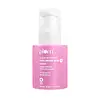What's inside
What's inside
 Key Ingredients
Key Ingredients

 Benefits
Benefits

 Concerns
Concerns

No concerns
 Ingredients Side-by-side
Ingredients Side-by-side

Water
Skin ConditioningPentylene Glycol
Skin ConditioningPropanediol
SolventGlycerin
HumectantRosa Damascena Flower Extract
MaskingSucrose
HumectantSorbitol
HumectantSodium Hyaluronate
HumectantSodium Benzoate
MaskingGluconolactone
Skin ConditioningCalcium Gluconate
HumectantBenzyl Alcohol
PerfumingHydroxyacetophenone
AntioxidantCaprylyl Glycol
EmollientCyclodextrin
AbsorbentSodium Gluconate
Skin ConditioningSodium Polyacryloyldimethyl Taurate
Emulsion StabilisingAmmonium Acryloyldimethyltaurate/Vp Copolymer
Water, Pentylene Glycol, Propanediol, Glycerin, Rosa Damascena Flower Extract, Sucrose, Sorbitol, Sodium Hyaluronate, Sodium Benzoate, Gluconolactone, Calcium Gluconate, Benzyl Alcohol, Hydroxyacetophenone, Caprylyl Glycol, Cyclodextrin, Sodium Gluconate, Sodium Polyacryloyldimethyl Taurate, Ammonium Acryloyldimethyltaurate/Vp Copolymer
Ingredients Explained
These ingredients are found in both products.
Ingredients higher up in an ingredient list are typically present in a larger amount.
Sodium Hyaluronate is hyaluronic acid's salt form. It is commonly derived from the sodium salt of hyaluronic acid.
Like hyaluronic acid, it is great at holding water and acts as a humectant. This makes it a great skin hydrating ingredient.
Sodium Hyaluronate is naturally occurring in our bodies and is mostly found in eye fluid and joints.
These are some other common types of Hyaluronic Acid:
Learn more about Sodium HyaluronateWater. It's the most common cosmetic ingredient of all. You'll usually see it at the top of ingredient lists, meaning that it makes up the largest part of the product.
So why is it so popular? Water most often acts as a solvent - this means that it helps dissolve other ingredients into the formulation.
You'll also recognize water as that liquid we all need to stay alive. If you see this, drink a glass of water. Stay hydrated!
Learn more about Water